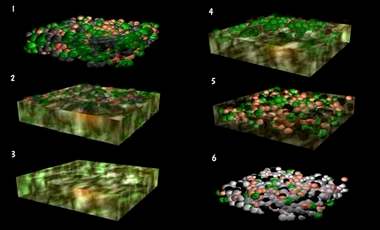As basalt begins to melt, and olivine is the last mineral to dissolve. As the melt (magma) is subjected to a different temperature/pressure gradient, (Probably due to the magma rising, the olivine begin to precipitate first.) (Last in - first out rule)
At some point the temperature/pressure curves favor the production of an amphibole by taking iron (Fe) form the melt and some calcium (Ca) from the melt. The result is a new mineral precipitating (the amphibole) with the pyroxene. As the melt continues to change the ratio of sodium (Na) to calcium (Ca), the calcium (Ca) is used up in the production of both the pyroxene and amphibole, by the time the feldspar precipitates it is more sodium (Na) rich as much of the calcium was depleted.
Result : The basaltic starting material melted and due to pressure and temperature changes, it produced an andesitic lava. ( Bowen's reaction series )

| Original rock created at high pressure and temperature (great depth). Composition includes: | ||
|
Olivine |
(Mg,Fe)2SiO4 |
|
|
Pyroxene |
(Ca,Mg)(SiO3)2 |
|
|
Feldspar |
( NaAlSi3O8 - CaAl2Si2O8 ) |
|
| After melt there is mix of molesules. ( fig. 3) | |
|
Magma |
Mg, Ca, Fe, Na, Al, SiO4 |
| As mixture begins to cool, the pressure is lower and the temperature is lowering, thus different minerals are favored. Olivine still precipitates first, but now both pyroxene and amphibole begin to grow. (fig. 4) | |||
|
Olivine |
(Mg,Fe)2SiO4 |
Amphibole |
|
|
Pyroxene |
(Ca,Mg)(SiO3)2 |
||
| The material still in solution is less rich in Ca and Fe because of the formation of the amphibole. (fig. 5) | ||
|
Magma |
Mg, Ca, Fe, Na, Al, SiO4 |
|
| Continued cooling of the less Ca, Fe rich melt now produces more sodium rich feldspars and more silica driving the overall rock composition toward an Andesite. | ||
|
Olivine |
(Mg, Fe)2SiO4 |
|
|
Pyroxene |
(Ca, Mg)(SiO3)2 |
|
|
Amphibole |
(Ca, Fe) Si2O6 |
|
|
Feldspar |
( NaAlSi3O8 - CaAl2Si2O8 ) |
|
Olivine can react with excess silica to produce some pyroxenes, pyroxenes with excess silica to produce amphiboles, amphiboles can react with excess silica to produce micas ...
Look for "skins" around various minerals that formed from magma recrystallization. This shows the presence of fractional crystallization. For instance, differing chemical composition from the inside of a feldspar to the outside, or a pyroxene coating around an olivine.
One of the important economic factors leading from this "fractional crystallization" is that the majority of nickel, vanadium, chromium and platinum ores are created by the fractional crystallization of magmatic materials. This leads to magmatic mineral deposits of economic significance.
| NEXT | TOC | PREV |